Battle of Culloden
The Battle of Culloden (/kəˈlɒdən/;[3] Scottish Gaelic: Blàr Chùil Lodair) was the final confrontation of the Jacobite rising of 1745. On 16 April 1746, the Jacobite army of Charles Edward Stuart was decisively defeated by a British government force under William Augustus, Duke of Cumberland, on Drummossie Moor near Inverness in the Scottish Highlands. It was the last pitched battle fought on British soil.
Charles was the eldest son of James Stuart, the exiled Stuart claimant to the British throne. Believing there was support for a Stuart restoration in both Scotland and England, he landed in Scotland in July 1745: raising an army of Scots Jacobite supporters, he took Edinburgh by September and defeated a British government force at Prestonpans. The government recalled 12,000 troops from the Continent to deal with the rising: a Jacobite invasion of England reached as far as Derby before turning back, having attracted relatively few English recruits.
The Jacobites, with limited French military support, attempted to consolidate their control of Scotland, where by early 1746 they were opposed by a substantial government army. A scrambled Jacobite victory at Falkirk failed to change the strategic situation: with supplies and pay running short and with the government troops resupplied and reorganised under the Duke of Cumberland, son of British monarch George II, the Jacobite leadership had few options left other than to stand and fight. The two armies eventually met at Culloden, on terrain that gave Cumberland's larger, well-rested force the advantage. The battle lasted only an hour, with the Jacobites suffering a bloody defeat; between 1,500 and 2,000 Jacobites were killed or wounded,[1][2] while about 300 government soldiers were killed or wounded.[1] While perhaps 5-6,000 Jacobites remained in arms in Scotland, the leadership took the decision to disperse, effectively ending the rising.[4]
Culloden and its aftermath continue to arouse strong feelings. The University of Glasgow awarded the Duke of Cumberland an honorary doctorate, but many modern commentators allege that the aftermath of the battle and subsequent crackdown on Jacobite sympathisers were brutal, earning Cumberland the sobriquet "Butcher". Efforts were subsequently made to further integrate the comparatively undeveloped Scottish Highlands into the Kingdom of Great Britain; civil penalties were introduced to undermine the Scottish clan system, which had provided the Jacobites with the means to rapidly mobilise an army.
Background
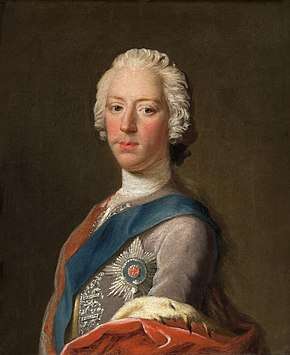
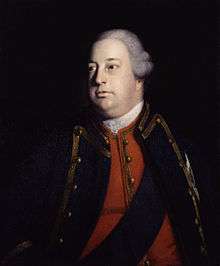
Queen Anne, the last monarch of the House of Stuart, died in 1714, with no living children. Under the terms of the Act of Settlement 1701, she was succeeded by her second cousin George I of the House of Hanover, who was a descendant of the Stuarts through his maternal grandmother, Elizabeth, a daughter of James VI and I. Many, however, particularly in Scotland and Ireland, continued to support the claim to the throne of Anne's exiled half-brother James, excluded from the succession under the Act of Settlement due to his Roman Catholic religion.
On 23 July 1745 James's son Charles Edward Stuart landed on Eriskay in the Western Islands in an attempt to reclaim the throne of Great Britain for his father, accompanied only by the "Seven Men of Moidart".[5] Most of his Scottish supporters advised he return to France, but his persuasion of Donald Cameron of Lochiel to back him encouraged others to commit and the rebellion was launched at Glenfinnan on 19 August. The Jacobite army entered Edinburgh on 17 September and James was proclaimed King of Scotland the next day.[6] Attracting more recruits, the Jacobites comprehensively defeated a government force at the Battle of Prestonpans on 21 September; the London government now recalled the Duke of Cumberland, the King's younger son and commander of the British army in Flanders, along with 12,000 troops.[7]
The Prince's Council, a committee formed of 15-20 senior leaders, met on 30 and 31 October to discuss plans to invade England. The Scots wanted to consolidate their position and although willing to assist an English rising or French landing, they would not do it on their own.[8] For Charles, the main prize was England; he argued removing the Hanoverians would guarantee an independent Scotland and assured the Scots that the French were planning to land in Southern England, while thousands of English supporters would join once across the border.[9]
Despite their doubts, the Council agreed to the invasion on condition the promised English and French support was forthcoming; the Jacobite army entered England on 8 November.[10] They captured Carlisle on 15 November, then continued south through Preston and Manchester, reaching Derby on 4 December. There had been no sign of a French landing or any significant number of English recruits, while they risked being caught between two armies, each one twice their size: Cumberland's, advancing north from London, and Wade's moving south from Newcastle upon Tyne. Despite Charles' opposition, the Council was overwhelmingly in favour of retreat and turned north the next day.[11]
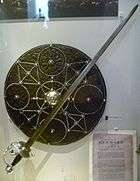

Apart from a minor skirmish at Clifton Moor, the Jacobite army evaded pursuit and crossed back into Scotland on 20 December. Entering England and returning was a considerable military achievement and morale was high; Jacobite strength increased to over 8,000 with the addition of a substantial north-eastern contingent under Lord Lewis Gordon, as well as Scottish and Irish regulars in French service.[12] French-supplied artillery was used to besiege Stirling Castle, the strategic key to the Highlands. On 17 January, the Jacobites dispersed a relief force under Henry Hawley at the Battle of Falkirk Muir, although the siege made little progress.[13]
On 1 February, the siege of Stirling was abandoned and the Jacobites retreated to Inverness.[14] Cumberland's army advanced along the coast and entered Aberdeen on 27 February; both sides halted operations until the weather improved.[15] Several French shipments were received during the winter but the Royal Navy's blockade led to shortages of both money and food; when Cumberland left Aberdeen on 8 April, Charles and his officers agreed giving battle was their best option.[16]
Opposing forces
Jacobite army
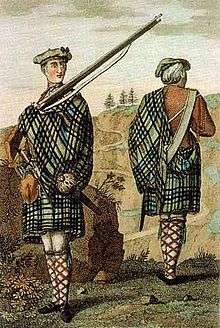
The Jacobite Army is often assumed to have been largely composed of Gaelic-speaking Catholic Highlanders: in reality nearly a quarter of the rank and file were recruited in Aberdeenshire, Forfarshire and Banffshire, with another 20% from Perthshire.[18][19] By 1745, Catholicism was the preserve of a small minority and large numbers of those who joined the Rebellion were Non-juring Episcopalians.[20] Although the army was predominantly Scots it contained a few English recruits plus significant numbers of Irish, Scottish and French professionals in French service with the Irish Brigade and Royal Ecossais.
To mobilise an army quickly, the Jacobites had relied heavily on the traditional right retained by many Scottish landowners to raise their tenants for military service. This assumed limited, short-term warfare: a long campaign demanded greater professionalism and training, and the colonels of some Highland regiments considered their men to be uncontrollable.[21][note 1] A typical 'clan' regiment was officered by the heavily-armed tacksmen, with their subtenants acting as common soldiers.[23][24] The tacksmen served in the front rank, taking proportionately high casualties; the gentlemen of the Appin Regiment suffered one quarter of those killed, and one third of those wounded from their regiment.[23] Many Jacobite regiments, notably those from the north-east, were organised and drilled more conventionally, but as with the Highland regiments were inexperienced and hurriedly trained.
The Jacobites started the campaign relatively poorly armed. Although Highlanders are often pictured equipped with a broadsword, targe and pistol, this applied mainly to officers and most men seem to have been drilled in conventional fashion with muskets as their main weapon.[25] After Culloden, Cumberland reported 2,320 firelocks were recovered from the battlefield, but only 190 broadswords; this may imply that of the roughly 1,000 Jacobites killed at Culloden, no more than one fifth carried a sword.[26] As the campaign progressed, supplies from France improved their equipment considerably and by the time of Culloden, many were equipped with 0.69 in (17.5 mm) calibre French and Spanish firelocks.[25]
During the latter stage of the campaign, the Jacobites were reinforced by French regulars, mainly drawn from Picquets or detachments from regiments of the Irish Brigade along with a Franco-Irish cavalry unit, Fitzjames's Horse. Around 500 men from the Irish Brigade fought in the battle, around 100 of whom were thought to have been recruited from 6th (Guise's) Foot taken prisoner at Fort Augustus. The Royal Écossais also contained British deserters; its commander attempted to raise a second battalion after the unit had arrived in Scotland.[27] Much of the Jacobite cavalry had been effectively disbanded due to a shortage of horses; Fitzjames', Strathallan's Horse, the Life Guards and the 'Scotch Hussars' retained a reduced presence at Culloden. The Jacobite artillery is generally regarded as playing little part in the battle, all but one of the cannon being 3-pounders.[27]
Government army
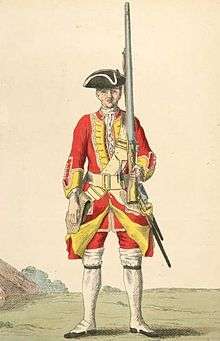
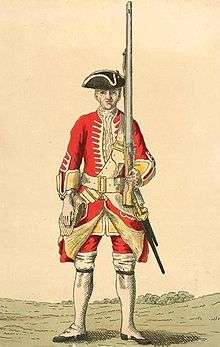
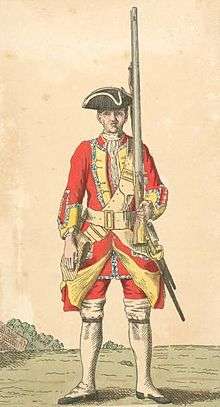

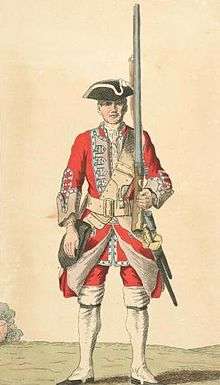
Cumberland's army at Culloden comprised 16 infantry battalions, including four Scottish units and one Irish.[28] The bulk of the infantry units had already seen action at Falkirk, but had been further drilled, rested and resupplied since then.
Many of the infantry were experienced veterans of Continental service, but on the outbreak of the Jacobite rising, extra incentives were given to recruits to fill the ranks of depleted units. On 6 September 1745, every recruit who joined the Guards before 24 September was given £6, and those who joined in the last days of the month were given £4. In theory, a standard single-battalion British infantry regiment was 815 strong, including officers, but were often smaller in practice and at Culloden, the regiments were not much larger than about 400 men.[29]
The government cavalry arrived in Scotland in January 1746. Many were not combat experienced, having spent the preceding years on anti-smuggling duties. A standard cavalryman had a Land Service pistol and a carbine, but the main weapon used by the British cavalry was a sword with a 35-inch blade.[30]
The Royal Artillery vastly out-performed their Jacobite counterparts during the Battle of Culloden. However, up until this point in the campaign, the government artillery had performed dismally. The main weapon of the artillery was the 3-pounder. This weapon had a range of 500 yards (460 m) and fired two kinds of shot: round iron and canister. The other weapon used was the Coehorn mortar. These had a calibre of 4 2⁄5 inches (11 cm).[31]
Lead-up to battle
On 30 January, following Hawley's defeat at Falkirk, the Duke of Cumberland arrived in Scotland to take command of the government forces. Cumberland decided to wait out the winter, and moved his troops northwards to Aberdeen. 5,000 Hessian troops, led by Prince Frederick of Hesse, took up position to the south to cut off any path of retreat for the Jacobites. The weather had improved to such an extent by 8 April that Cumberland resumed the campaign: his army reached Cullen on 11 April, where it was joined by six further battalions and two cavalry regiments.[32] Days later, the government army approached the River Spey, guarded by a Jacobite detachment of 2,000 under Lord John Drummond. Rather than offer resistance Drummond retreated towards Elgin and then to Nairn, an act for which he was sharply criticised after the rising by several participants. By 14 April, the Jacobites had evacuated Nairn, and Cumberland's army camped at Balblair just west of the town.[33]
Several significant Jacobite units were still en route or engaged far to the north, but on learning of the government advance their main army of about 5,400 left its base at Inverness on 15 April and assembled in battle order 5 miles (8 km) to the east.[34] The Jacobite leadership was divided on whether to give battle or abandon Inverness but with supplies running out and most of their remaining stores and oatmeal held in the town, few options were left.[35] The Jacobite adjutant-general, John O'Sullivan, identified a suitable site for a defensive action at Drummossie Moor,[36] a stretch of open moorland between the walled Culloden Park[37] enclosures to the north and those of Culwhiniac to the south.[38]
Jacobite lieutenant-general Lord George Murray "did not like the ground", as it was relatively flat and open, suggesting an alternative, steeply sloping site near Daviot Castle. This was inspected by Brigadier Stapleton of the Irish Brigade and Colonel Ker on the morning of 15 April, but rejected by them as the site was overlooked and the ground "mossy and soft": Murray's choice also failed to protect the road into Inverness.[39] The issue had not been fully resolved by the time of the battle and in the event circumstances largely dictated the point at which the Jacobites formed line, some distance to the west of the site chosen by Sullivan.[40]
Night attack at Nairn
On 15 April, the government army celebrated Cumberland's twenty-fifth birthday by issuing two gallons of brandy to each regiment.[32] At Murray's suggestion, the Jacobites tried that evening to repeat the success of Prestonpans by carrying out a night attack on the government encampment.
Murray proposed that they set off at dusk and march to Nairn; he planned to have the right wing of the first line attack Cumberland's rear, while the Duke of Perth with the left wing would attack the government's front. In support of Perth, Lord John Drummond and Charles would bring up the second line. The Jacobite force, however, started out well after dark, partly due to concerns they would be spotted by ships of the Royal Navy then in the Moray Firth. Murray led them across country with the intention of avoiding government outposts: Murray's one time aide-de-camp, James Chevalier de Johnstone later wrote, "this march across country in a dark night which did not allow us to follow any track [was] accompanied with confusion and disorder".[41]
By the time the leading troop had reached Culraick, still 2 miles (3.2 km) from where Murray's wing was to cross the River Nairn and encircle the town, there was only one hour left before dawn. After a heated council with other officers, Murray concluded that there was not enough time to mount a surprise attack and that the offensive should be aborted. Sullivan went to inform Charles Edward Stuart of the change of plan, but missed him in the dark. Meanwhile, instead of retracing his path back, Murray led his men left, down the Inverness road. In the darkness, while Murray led one-third of the Jacobite forces back to camp, the other two-thirds continued towards their original objective, unaware of the change in plan. One account of that night even records that Perth's men made contact with government troops before realising the rest of the Jacobite force had turned home. A few historians, such as Jeremy Black and Christopher Duffy, have suggested that if Perth had carried on the night attack might have remained viable, though most have disagreed, as perhaps only 1200 of the Jacobite force accompanied him.[42][43][44]
Not long after the exhausted Jacobite forces had made it back to Culloden, an officer of Lochiel's regiment, who had been left behind after falling asleep in a wood, arrived with a report of advancing government troops.[41] By then, many Jacobite soldiers had dispersed in search of food or returned to Inverness, while others were asleep in ditches and outbuildings; several hundred of their army may have missed the battle.
Battle on Culloden Moor
.svg.png)
.jpg)
Following the abortive night attack, the Jacobites formed up in substantially the same battle order as the previous day, with the Highland regiments forming the first line. They faced north-east over common grazing land, with the Water of Nairn about 1 km to their right.[45] Their left wing, anchored on the Culloden Park walls, was under the command of the titular Duke of Perth, James Drummond; his brother John Drummond commanded the centre. The right wing, flanked by the Culwhiniac enclosure walls, was led by Murray. Behind them the 'Low Country' regiments were drawn up in column, in accordance with French practice. During the morning snow and hail "started falling very thick" onto the already wet ground, later turning to rain, though the weather turned fair as the battle started.[46]
Cumberland's army had pitched camp and were underway by 5 am, leaving the main Inverness road and marching across country. By 10 am the Jacobites finally saw them approaching at a distance of around 4 km; at 3 km from the Jacobite position Cumberland gave the order to form line, and the army marched forward in full battle order.[47] John Daniel, an Englishman serving with Charles's army, recorded that on seeing the government troops the Jacobites began to "huzza and bravado them", though without response: "on the contrary, they continued proceding, like a deep sullen river".[48] Once within 500 metres, Cumberland moved his artillery up through the ranks.[47]
As Cumberland's forces formed into line of battle, it became clear that their right flank was in an exposed position and Cumberland moved up additional cavalry and other units to reinforce it.[49] In the Jacobite lines, Sullivan moved two battalions of Lord Lewis Gordon's regiment to cover the walls at Culwhiniac against a possible flank attack by government dragoons. Murray also moved the Jacobite right slightly forwards: this "changement", as Sullivan called it, had the unintended result of skewing the Jacobite line and opening gaps, so Sullivan ordered Perth and Glenbucket's regiments from the second line to the left of the front rank, and the Edinburgh Regiment to the centre. While the Jacobite front rank now substantially outnumbered that of Cumberland, their reserve was further depleted, increasing their reliance on the first line attack.[50]
Artillery exchange
At approximately 1 p.m. Finlayson's Jacobite batteries opened fire, possibly in response to Cumberland sending forward Lord Bury to within 100 metres of the Jacobite lines to "ascertain the strength of their battery".[51] The government artillery responded shortly afterwards: while some later Jacobite memoirs suggest their troops were then subjected to artillery bombardment for 30 minutes or more while Charles delayed an advance, government accounts suggest a much shorter exchange before the Jacobites attacked. Campbell of Airds, in the rear, timed it at 9; Cumberland's aide-de-camp Yorke suggested only 2 or 3 minutes.[52]
The duration implies that the government artillery are unlikely to have fired more than thirty rounds at extreme range: statistical analysis concludes that this would have caused only 20-30 Jacobite casualties at this stage, rather than the hundreds suggested by some accounts.[53]
Jacobite advance
Shortly after 1 pm, Charles issued an order to advance, which Col. Harry Kerr of Graden first took to Perth's regiment, on the extreme left. He then rode down the Jacobite line giving orders to each regiment in turn; Sir John MacDonald and Brigadier Stapleton were also sent forward to repeat the order.[54] As the Jacobites left their lines, the government gunners switched to canister; this was augmented by fire from the coehorn mortars situated behind the government front line. As there was no need for careful aiming when using canister the rate of fire increased dramatically, and the Jacobites found themselves advancing into heavy fire.[51]
On the Jacobite right, the Atholl Brigade, Lochiel's and the Appin Regiment left their start positions and charged towards Barrell's and Munro's regiments. Within a few hundred yards, however, the centre regiments, Lady Mackintosh's and Lovat's, had begun to swerve rightwards, either trying to avoid canister fire or in order to follow the firmer ground along the road running diagonally across Drummossie Moor. The five regiments became entangled as a single mass, converging on the government left. The confusion was worsened when the three largest regiments lost their commanding officers, who were all at the front of the advance: MacGillivray and MacBean of Lady Mackintosh's both went down; Inverallochie of Lovat's fell, and Lochiel had his ankles broken by canister within a few yards of the government lines.
The Jacobite left, by contrast, advanced much more slowly, hampered by boggy ground and by having several hundred yards further to cover. According to the account of Andrew Henderson, Lord John Drummond walked across the front of the Jacobite lines to try and tempt the government infantry into firing early, but they maintained their discipline. The three MacDonald regiments - Keppoch's, Clanranald's and Glengarry's - stalled before resorting to ineffectual long-range musket fire; they also lost senior officers, as Clanranald was wounded and Keppoch killed. The smaller units on their right - Maclachlan's Regiment and Chisholm's and Monaltrie's battalions - advanced into an area swept by artillery fire, and suffered heavy losses before falling back.
Engagement of government left wing

The Jacobite right was particularly hard hit by a volley from the government regiments at nearly point blank range, but many of its men still reached the government lines and, for the first time, a battle was decided by a direct clash between charging Highlanders and formed infantry equipped with muskets and socket bayonets. The brunt of the Jacobite impact, led by Lochiel's regiment, was taken by just two government regiments – Barrell's 4th Foot and Dejean's 37th Foot. Barrell's lost 17 and suffered 108 wounded, out of a total of 373 officers and men. Dejean's lost 14 and had 68 wounded, with this unit's left wing taking a disproportionately higher number of casualties. Barrell's regiment temporarily lost one of its two colours.[note 2] Major-General Huske, who was in command of the government's second line, quickly organised the counter attack. Huske ordered forward all of Lord Sempill's Fourth Brigade which had a combined total of 1,078 men (Sempill's 25th Foot, Conway's 59th Foot, and Wolfe's 8th Foot). Also sent forward to plug the gap was Bligh's 20th Foot, which took up position between Sempill's 25th and Dejean's 37th. Huske's counter formed a five battalion strong horseshoe-shaped formation which trapped the Jacobite right wing on three sides.[55]
Poor Barrell's regiment were sorely pressed by those desperadoes and outflanked. One stand of their colours was taken; Collonel Riches hand cutt off in their defence ... We marched up to the enemy, and our left, outflanking them, wheeled in upon them; the whole then gave them 5 or 6 fires with vast execution, while their front had nothing left to oppose us, but their pistolls and broadswords; and fire from their center and rear, (as, by this time, they were 20 or 30 deep) was vastly more fatal to themselves, than us.
— Captain-Lieutenant James Ashe Lee of Wolfe's 8th Foot[56]
.svg.png)
With the Jacobite left under Perth failing to advance further, Cumberland ordered two troops of Cobham's 10th Dragoons to ride them down. The boggy ground, however, impeded the cavalry and they turned to engage the Irish Picquets whom Sullivan and Lord John Drummond had brought up in an attempt to stabilise the deteriorating Jacobite left flank. Cumberland later wrote: "They came running on in their wild manner, and upon the right where I had place myself, imagining the greatest push would be there, they came down there several times within a hundred yards of our men, firing their pistols and brandishing their swords, but the Royal Scots and Pulteneys hardly took their fire-locks from their shoulders, so that after those faint attempts they made off; and the little squadrons on our right were sent to pursue them".[58][59]
Jacobite collapse and rout
With the collapse of the left wing, Murray brought up the Royal Écossais and Kilmarnock's Footguards who were still at this time unengaged, but by the time they had been brought into position, the Jacobite first line was in rout. The Royal Écossais exchanged musket fire with Campbell's 21st and commenced an orderly retreat, moving along the Culwhiniac enclosure in order to shield themselves from artillery fire. Immediately the half battalion of Highland militia, commanded by Captain Colin Campbell of Ballimore, which had stood inside the enclosure ambushed them. In the encounter Campbell of Ballimore was killed along with five of his men. The result was that the Royal Écossais and Kilmarnock's Footguards were forced out into the open moor and were engaged by three squadrons of Kerr's 11th Dragoons: the fleeing Jacobites must have put up a fight, for Kerr's 11th recorded at least 16 horses killed during the entirety of the battle.
The Irish Picquets under Stapleton bravely covered the Highlanders' retreat from the battlefield, preventing the fleeing Jacobites from suffering heavy casualties: this action cost half of the 100 casualties they suffered in the battle.[60] The Royal Écossais appear to have retired from the field in two wings; one part surrendered after suffering 50 killed or wounded, but their colours were not taken and a large number retired from the field with the Jacobite Lowland regiments.[61] A few Highland regiments also withdrew in good order, notably Lovat's first battalion who retired with colours flying; the government dragoons let them withdraw rather than risk a confrontation.[62]
.svg.png)
The stand by the French regulars gave Charles and other senior officers time to escape. Charles seems to have been rallying Perth's and Glenbucket's regiments when Sullivan rode up to Captain Shea, commander of his bodyguard: "Yu see all is going to pot. Yu can be of no great succor, so before a general deroute wch will soon be, Seize upon the Prince & take him off ...".[61] Contrary to government depictions of Charles as a coward, he yelled "they won't take me alive!" and called for a final charge into the government lines:[65] Shea however followed Sullivan's advice and led Charles from the field, accompanied by Perth and Glenbucket's regiments.
From this point on the fleeing Jacobite forces were split into several groups: the Lowland regiments retired in order southwards, making their way to Ruthven Barracks, while the remains of the Jacobite right wing also retired to the south. The MacDonald and other Highland left wing regiments however were cut off by the government cavalry, and forced to retreat down the road to Inverness. The result was that they were a clear target for government dragoons: Major-general Humphrey Bland led the pursuit of the fleeing Highlanders, giving "Quarter to None but about Fifty French Officers and Soldiers".[61]
Conclusion: casualties and prisoners
Jacobite casualties are estimated at 1,500–2,000 killed or wounded, with many of these occurring in the pursuit after the battle.[1][2] Cumberland's official list of prisoners taken includes 154 Jacobites and 222 "French" prisoners (men from the 'foreign units' in the French service). Added to the official list of those apprehended were 172 of the Earl of Cromartie's men, captured after a brief engagement the day before near Littleferry.
In striking contrast to the Jacobite losses, the government losses were reported as 50 dead and 259 wounded. Of the 438 men of Barrell's 4th Foot, 17 were killed and 104 were wounded. However, a large proportion of those recorded as wounded are likely to have died of their wounds: only 29 men out of the 104 wounded from Barrell's 4th Foot later survived to claim pensions, while all six of the artillerymen recorded as wounded died.[1]
Several senior Jacobite commanding officers were casualties including Keppoch, Viscount Strathallan, commissary-general Lachlan Maclachlan and Walter Stapleton, who died of wounds shortly after the battle. Others, including Kilmarnock, were captured. The only government officer casualty of high rank was Lord Robert Kerr, the son of William Kerr, 3rd Marquess of Lothian. Sir Robert Rich, 5th Baronet, whom was a lieutenant-colonel and the senior officer commanding Barrell's 4th Foot, was badly wounded, losing his left hand and receiving several wounds to his head, and a number of captains and lieutenants had also been wounded.
Aftermath

Collapse of the Jacobite campaign
As the first of the fleeing Highlanders approached Inverness they were met by the 2nd battalion of Lovat's regiment, led by the Master of Lovat. It has been suggested that Lovat shrewdly switched sides and turned upon the retreating Jacobites, an act that would explain his remarkable rise in fortune in the years that followed.[66]
Following the battle, the Jacobites' Lowland regiments headed south, towards Corrybrough and made their way to Ruthven Barracks, while their Highland units made their way north, towards Inverness and on through to Fort Augustus. There they were joined by Barisdale's battalion of Glengarry's regiment and a small battalion of MacGregors.[66] At least two of those present at Ruthven, James Johnstone and John Daniel, recorded that the Highland troops remained in good spirits despite the defeat and eager to resume the campaign. At this point, continuing Jacobite resistance remained potentially viable in terms of manpower: at least a third of the army had either missed or slept through Culloden, which along with survivors from the battle gave a potential force of 5-6000 men.[67] However the roughly 1,500 men who assembled at Ruthven Barracks received orders from Charles to the effect that the army should disperse until he returned with French support.[68]
Similar orders must have been received by the Highland units at Fort Augustus, and by 18 April the majority of the Jacobite army was disbanded. Officers and men of the units in French service made for Inverness, where they surrendered as prisoners of war on 19 April. Most of the rest of the army broke up, with men heading for home or attempting to escape abroad,[66] although the Appin Regiment amongst others was still in arms as late as July.
Many senior Jacobites made their way to Loch nan Uamh, where Charles Edward Stuart had first landed at the outset of the campaign in 1745. Here on 30 April they were met by two French frigates – the Mars and Bellone. Two days later the French ships were spotted and attacked by three smaller Royal Navy sloops – the Greyhound, Baltimore, and Terror. The result was the last real engagement of the campaign; during the six hours in which the battle continued the Jacobites recovered cargo which had been landed by the French ships, including £35,000 of gold.[66]
With visible proof that the French had not deserted them, a group of Jacobite leaders attempted to prolong the campaign. On 8 May, nearby at Murlaggan, Lochiel, Lochgarry, Clanranald and Barisdale all agreed to rendezvous at Invermallie on 18 May, as did Lord Lovat and his son. The plan was that there they would be joined by what remained of Keppoch's men and Macpherson of Cluny's regiment, which had not taken part in the battle at Culloden. However, things did not go as planned; after about a month of relative inactivity, Cumberland moved his army into the Highlands and on 17 May three battalions of regulars and eight Highland companies reoccupied Fort Augustus. The same day, the Macphersons surrendered. On the day of the planned rendezvous, Clanranald never appeared and Lochgarry and Barisdale only showed up with about 300 combined, most of whom immediately dispersed in search of food: Lochiel, who commanded possibly the strongest Jacobite regiment at Culloden, was only able to muster 300 men. The group dispersed, and the following week the Government launched punitive expeditions into the Highlands which continued throughout the summer.[66][68]
Following his flight from the battle, Charles Edward Stuart made his way towards the Hebrides, accompanied by a small group of supporters. By 20 April, Charles had reached Arisaig on the west coast of Scotland. After spending a few days with his close associates, he sailed for the island of Benbecula in the Outer Hebrides. From there he travelled to Scalpay, off the east coast of Harris, and from there made his way to Stornoway.[69] For five months Charles criss-crossed the Hebrides, constantly pursued by government supporters and under threat from local lairds who were tempted to betray him for the £30,000 upon his head.[70] During this time he met Flora Macdonald, who famously aided him in a narrow escape to Skye. Finally, on 19 September, Charles reached Borrodale on Loch nan Uamh in Arisaig, where his party boarded two small French ships, which ferried them to France.[69] He never returned to Scotland.
Repercussions and persecution
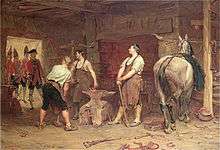
The morning following the Battle of Culloden, Cumberland issued a written order reminding his men that "the public orders of the rebels yesterday was to give us no quarter".[note 3] Cumberland alluded to the belief that such orders had been found upon the bodies of fallen Jacobites. In the days and weeks that followed, versions of the alleged orders were published in the Newcastle Journal and the Gentleman's Journal. Today only one copy of the alleged order to "give no quarter" exists.[72] It is however considered to be nothing but a poor attempt at forgery, for it is neither written nor signed by Murray, and it appears on the bottom half of a copy of a declaration published in 1745. In any event, Cumberland's order was not carried out for two days, after which contemporary accounts report then that for the next two days the moor was searched and all those wounded were put to death. On the other hand, the orders issued by Lord George Murray for the conduct of the aborted night attack in the early hours of 16 April suggest that it would have been every bit as merciless. The instructions were to use only swords, dirks and bayonets, to overturn tents, and subsequently to locate "a swelling or bulge in the fallen tent, there to strike and push vigorously".[72][note 4] In total, over 20,000 head of livestock, sheep, and goats were driven off and sold at Fort Augustus, where the soldiers split the profits.[74]
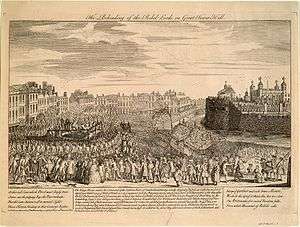
While in Inverness, Cumberland emptied the jails that were full of people imprisoned by Jacobite supporters, replacing them with Jacobites themselves.[66] Prisoners were taken south to England to stand trial for high treason. Many were held on hulks on the Thames or in Tilbury Fort, and executions took place in Carlisle, York and Kennington Common.[70] The common Jacobite supporters fared better than the ranking individuals. In total, 120 common men were executed, one third of them being deserters from the British Army.[70] [note 5] The common prisoners drew lots amongst themselves and only one out of twenty actually came to trial. Although most of those who did stand trial were sentenced to death, almost all of these had their sentences commuted to penal transportation to the British colonies for life by the Traitors Transported Act 1746 (20 Geo. II, c. 46).[77] In all, 936 men were thus transported, and 222 more were banished. Even so, 905 prisoners were actually released under the Act of Indemnity which was passed in June 1747. Another 382 obtained their freedom by being exchanged for prisoners of war who were held by France. Of the total 3,471 prisoners recorded, nothing is known of the fate of 648.[78] The high ranking "rebel lords" were executed on Tower Hill in London.
Following up on the military success won by their forces, the British Government enacted laws further to integrate Scotland – specifically the Scottish Highlands – with the rest of Britain. Members of the Episcopal clergy were required to give oaths of allegiance to the reigning Hanoverian dynasty.[79] The Heritable Jurisdictions (Scotland) Act 1746 ended the hereditary right of landowners to govern justice upon their estates through barony courts.[80] Previous to this act, feudal lords (which included clan chiefs) had considerable judicial and military power over their followers – such as the oft quoted power of "pit and gallows".[70][79] Lords who were loyal to the Government were greatly compensated for the loss of these traditional powers, for example the Duke of Argyll was given £21,000.[70] Those lords and clan chiefs who had supported the Jacobite rebellion were stripped of their estates and these were then sold and the profits were used to further trade and agriculture in Scotland.[79] The forfeited estates were managed by factors. Anti-clothing measures were taken against the highland dress by an Act of Parliament in 1746. The result was that the wearing of tartan was banned except as a uniform for officers and soldiers in the British Army and later landed men and their sons.[81]
Culloden battlefield today
Today, a visitor centre is located near the site of the battle. This centre was first opened in December 2007, with the intention of preserving the battlefield in a condition similar to how it was on 16 April 1746.[83] One difference is that it currently is covered in shrubs and heather; during the 18th century, however, the area was used as common grazing ground, mainly for tenants of the Culloden estate.[84] Those visiting can walk the site by way of footpaths on the ground and can also enjoy a view from above on a raised platform.[85] Possibly the most recognisable feature of the battlefield today is the 20 feet (6.1 m) tall memorial cairn, erected by Duncan Forbes in 1881.[82] In the same year Forbes also erected headstones to mark the mass graves of the clans.[86] The thatched roofed farmhouse of Leanach which stands today dates from about 1760; however, it stands on the same location as the turf-walled cottage that probably served as a field hospital for government troops following the battle.[84] A stone, known as "The English Stone", is situated west of the Old Leanach cottage and is said to mark the burial place of the government dead.[87] West of this site lies another stone, erected by Forbes, marking the place where the body of Alexander McGillivray of Dunmaglass was found after the battle.[88][89] A stone lies on the eastern side of the battlefield that is supposed to mark the spot where Cumberland directed the battle.[90] The battlefield has been inventoried and protected by Historic Scotland under the Historic Environment (Amendment) Act 2011.[91]
.jpg)
Since 2001, the site of the battle has undergone topographic, geophysical, and metal detector surveys in addition to archaeological excavations. Interesting finds have been made in the areas where the fiercest fighting occurred on the government left wing, particularly where Barrell's and Dejean's regiments stood. For example, pistol balls and pieces of shattered muskets have been uncovered here which indicate close quarters fighting, as pistols were only used at close range and the musket pieces appear to have been smashed by pistol/musket balls or heavy broadswords. Finds of musket balls appear to mirror the lines of men who stood and fought. Some balls appear to have been dropped without being fired, some missed their targets, and others are distorted from hitting human bodies. In some cases it may be possible to identify whether the Jacobites or government soldiers fired certain rounds, because the Jacobite forces are known to have used a large quantity of French muskets which fired a slightly smaller calibre shot than that of the British Army's Brown Bess. Analysis of the finds confirms that the Jacobites used muskets in greater numbers than has traditionally been thought. Not far from where the hand-to-hand fighting took place, fragments of mortar shells have been found.[92] Though Forbes's headstones mark the graves of the Jacobites, the location of the graves of about sixty government soldiers is unknown. The recent discovery of a 1752 silver Thaler, from the Duchy of Mecklenburg-Schwerin, may however lead archaeologists to these graves. A geophysical survey, directly beneath the spot where the coin was found, seems to indicate the existence of a large rectangular burial pit. It is thought possible that the coin was dropped by a soldier who once served on the continent, while he visited the graves of his fallen comrades.[92] The National Trust of Scotland is currently attempting to restore Culloden Moor, as closely as possible, to the state it was in during the Battle of Culloden Moor. They are also attempting to expand the land under its care to ensure the full battlefield is protected under the NTS. Another goal is to restore Leannach Cottage and allow visitors to once again tour the interior.
Order of battle: Culloden, 16 April 1746
Jacobite army
Charles Edward Stuart
Colonel John William Sullivan
| Division | Unit | Notes | |
|---|---|---|---|
| Escort troop | Fitzjames' Horse: 16 men. Lifeguards: 16 men. |
Commanded by Capt O'Shea. This unit was the prince's escort. | |
| Lord George Murray's Division | Atholl Brigade: 500 men (3 battalions). | Raised not as a clan but as a feudal levy. Possibly consisted of 3 regiments. Suffered badly from desertion. | |
| Cameron of Lochiel's Regiment: ~ 650–700 men.[93] | Led by Sir Donald Cameron of Lochiel. Regarded as one of the strongest Jacobite units, and as elite. | ||
| Stewarts of Appin or Appin Regiment: 250 men.[94] | Led by Charles Stuart of Ardsheal. The regiment suffered from desertion. During the campaign it suffered 90 killed, 65 wounded. | ||
| Lord John Drummond's Division | Lord Lovat's Regiment: ~ 300 men.[95] | Led at Culloden by Charles Fraser of Inverallochie, whose battalion was numbered at about 300. The Master of Lovat's battalion missed the battle by several hours.[96] | |
| Lady Mackintosh's Regiment: ~ 350 men.[97] | Sometimes referred to in secondary sources as Clan Chattan Regiment. A composite unit, like the Atholl Brigade. Led by Alexander McGillivray of Dunmaglass. Lost most of its officers at Culloden. | ||
| Farquharson of Monaltrie's Battalion: 150 men. | Consisted of mostly Highlanders but not all. Described by James Logie as "dressed in highland clothes mostly".[note 6] Included a party of MacGregors.[note 7] | ||
| Maclachlans and Macleans: ~ 200 men.[100] | Commanded by Lachlan Maclachlan of Castle Lachlan and Maclean of Drimmin (who served as Lt Col). The unit campaigned as part of the Athole Brigade, though fought at Culloden for the first time as a stand-alone unit.[101] | ||
| Chisholms of Strathglass: ~ 80 men.[102] | This very small unit was led by Roderick Og Chisholm. Suffered very heavy casualties at Culloden.[101] | ||
| Duke of Perth's Division | MacDonald of Keppoch's Regiment. 200 men. | Commanded by Alexander MacDonald of Keppoch. This small regiment consisted of MacDonalds of Keppoch, MacDonalds of Glencoe,[note 8] Mackinnons and MacGregors.[note 9][101] | |
| MacDonald of Clanranald's Regiment: 200 men. | Commanded by MacDonald of Clanranald, younger, who was wounded during the battle. Disbanded at Fort Augustus about 18 April 1746.[101] | ||
| MacDonnell of Glengarry's Regiment: 500 men. | Commanded by Donald MacDonnell of Lochgarry. This regiment included a unit of Grants of Glenmoriston and Glen Urquhart.[note 10] | ||
| John Roy Stuart's Division (reserve) | Lord Lewis Gordon's Regiment | John Gordon of Avochie's Battalion: 300 men. | Commanded by John Gordon of Avochie.[note 11] |
| Moir of Stonywood's Battalion: 200 men. | Commanded by James Moir of Stonywood. The unit, unlike the others of this regiment, was made up largely of volunteers.[101] | ||
| 1/Lord Ogilvy's Regiment: 200 men. | Commanded by Thomas Blair of Glassclune. | ||
| 2/Lord Ogilvy's Regiment: 300 men. | Commanded by Sir James Johnstone. | ||
| John Roy Stuart's Regiment: ~ 200 men. | Commanded by Maj Patrick Stewart. Also known as the Edinburgh Regiment, because of where it was raised.[note 12] | ||
| Footguards: ~ 200 men. | Commanded by William, Lord Kilmarnock. A composite unit.[note 13] | ||
| Glenbuchet's Regiment: 200 men. | Commanded by John Gordon of Glenbuchat. | ||
| Duke of Perth's Regiment: 300 men. | James Drummond, Master of Strathallan. The unit included a party of MacGregors.[note 14] | ||
| Irish Brigade | Garde Écossaise: 350 men. | Commanded by Lieutenant-Colonel Lord Lewis Drummond. | |
| Irish Picquets: 302 men. | Commanded by Lieutenant-Colonel Walter Stapleton. | ||
| Cavalry (Commanded by Sir John MacDonald of Fitzjames' Horse) |
Right Squadron | Fitzjames' Horse: 70 men. | Commanded by Capt William Bagot. |
| Lifeguards: 30 men. | Commanded by David, Lord Elcho. | ||
| Left Squadron | Scotch Hussars: 36 men. | Commanded by Maj John Bagot. | |
| Strathallan's Horse: 30 men. | Commanded by William, Lord Strathallan. | ||
|
Artillery |
11 x 3-pounders. | Commanded by Capt John Finlayson. | |
| 1 x 4-pounders. | Commanded by Capt du Saussay. | ||
Government army
Captain-General: Duke of Cumberland
Commander-in-Chief North Britain: Lieutenant-General Henry Hawley
| Division | Unit | Notes | |
|---|---|---|---|
| Escort troop | Duke of Cumberland's Hussars: ~ 20 men. | Made up of Austrians and Germans. | |
| Advance Guard (Commanded by Maj-Gen Humphrey Bland) |
10th (Cobham's) Dragoons: 276 officers & men. | Commanded by Maj Peter Chaban. | |
| 11th (Kerr's) Dragoons: 267 officers & men. | Commanded by Lt Col William, Lord Ancram. | ||
| The Highland Battalion: ~ 300 rank and file. | The Highland Battalion consisted of eight companies of soldiers, some regular and some militia.[107] Four of these companies were from the Campbell of Argyll Militia, three of these companies were from Loudon's 64th Highland Regiment and one company was from the 43rd (Black Watch) Highland Regiment.[107] The battalion was commanded by Lt Col John Campbell, 5th Duke of Argyll of the 64th Highlanders.[107] There was also one non-regimented Independent Highland Company (militia) present at the battle that had been raised by William Sutherland, 17th Earl of Sutherland, but it was kept in reserve.[108][109] | ||
| Front Line (1st Division) (Maj-Gen. William Anne van Keppel, Earl of Albemarle) |
First Brigade | 2/1st (Royal) Regiment: 401 rank & file. | Commanded by Lt Col John Ramsay. |
| 34th (Cholmondley's) Foot: 339 rank & file. | Commanded by Lt Col Charles Jeffreys. | ||
| 14th (Price's) Foot: 304 rank & file. | Commanded by Lt Col John Grey. | ||
| Third Brigade | 21st (North British) Fusiliers: 358 rank & file. | Commanded by Maj Charles Colvill. | |
| 37th (Dejean's) Foot: 426 rank & file. | Commanded by Col Louis Dejean. | ||
| 4th (Barrell's) Foot: 325 rank & file. | Commanded by Lt Col Robert Rich. | ||
| Second Line (Commanded by Maj-Gen John Huske) |
Second Brigade | 3rd Foot (Buffs): 413 rank & file. | Commanded by Lt Col George Howard. |
| 36th (Fleming's) Foot: 350 rank & file. | Commanded by Lt Col George Jackson. | ||
| 20th (Sackville's) Foot: 412 rank & file. | Commanded by Col Lord George Sackville. | ||
| Fourth Brigade | 25th (Sempill's) Foot: 429 rank & file. | Commanded by Lt Col David Cunynghame. | |
| 59th (Conway's) Foot: 325 rank & file. | Commanded by Col Henry Conway. | ||
| 8th (Edward Wolfe's) Foot: 324 rank & file. | Commanded by Lt Col Edward Martin. | ||
| Reserve | Duke of Kingston's 10th Horse: 211 officers & men. | Commanded by Lt Col John Mordaunt. | |
| Fifth Brigade (Brig John Mordaunt) |
13th (Pulteney's) Foot: 510 rank & file. | Commanded by Lt Col Thomas Cockayne. | |
| 62nd (Batereau's) Foot: 354 rank & file. | Commanded by Col John Batereau. | ||
| 27th (Blakeney's) Foot: 300 rank & file. | Commanded by Lt Col Francis Leighton. | ||
| Artillery | 106 NCOs & Gunners 10 x 3-pounder cannon 6 x Coehorn mortars |
Commanded by Commander Royal Artillery (CRA): Maj William Belford and Captain-Lieutenant John Godwin. | |
See the following reference for source of tables[110]
- Of the 16 British infantry battalions, 11 were English, 4 were Scottish (3 Lowland + 1 Highland), and 1 Irish battalion.
- Of the 3 British battalions of horse (dragoons), 2 were English and 1 was Scottish.
British Army casualties
| Regiment | Killed | Wounded |
|---|---|---|
| 1st (Royal) Regiment | 0 | 4 |
| 3rd Foot (Buffs)[111] | 1 | 2 |
| 4th (Barrell's) Foot | 17 | 108 |
| 8th (Wolfe's) Foot | 0 | 1 |
| 13th (Pulteney's) Foot | 0 | 0 |
| 14th (Price's) Foot | 1 | 9 |
| 20th (Sackville's) Foot[112] | 4 | 17 |
| 21st (North British) Fusiliers[113] | 0 | 7 |
| 25th (Sempill's) Foot | 1 | 13 |
| 34th (Cholmondley's) Foot | 1 | 2 |
| 36th (Fleming's) Foot | 0 | 6 |
| 37th (Dejean's) Foot | 14 | 68 |
| 59th (Conway's) Foot [note 15] | 1 | 5 |
| 62nd (Batereau's) Foot | 0 | 3 |
| 64th (Loudon's) Foot | 6 | 3 |
| Argyll Militia | 0 | 1 |
| Royal Artillery | 0 | 6 |
| Duke of Kingston's 10th Horse | 0 Horses: 2 |
1 Horses: 1 |
| 10th (Cobham's) Dragoons | 1 Horses: 4 |
0 Horses: 5 |
| 11th (Kerr's) Dragoons | 3 Horses: 4 |
3 Horses: 15 |
See following reference for source of table[114]
The Battle of Culloden in art
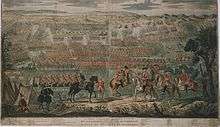
- An Incident in the Rebellion of 1745 (as shown in the info box at the top of this page), by David Morier, often known as "The Battle of Culloden", is the best-known portrayal of the battle, and the best-known of Morier's works. It depicts the attack of the Highlanders against Barrell's Regiment, and is based on sketches made by Morier in the immediate aftermath of the battle.
- David Morier in fact made two paintings depicting the battle, the second (pictured right) is a coloured woodcut painting that shows a plan of the battlefield.[115]
- Augustin Heckel's The Battle of Culloden (1746; reprinted 1797) is held by the National Galleries of Scotland.[116]
- Frank Watson Wood, (1862–1953). Although he was better known as a Naval artist who mainly painted in water colours Frank Watson Wood painted The Highland Charge at the Battle of Culloden in oil. Frank Watson Wood exhibited at Royal Scotland Academy, The Royal Society of Painters in Water Colours and The Royal Academy.
- Handel's oratorio Judas Maccabaeus was written as a tribute to the Duke of Cumberland following the Battle of Culloden.[117]
- The Battle of Culloden and consequent imprisonment and execution of the Jacobite prisoners of war is depicted in the song "Tam kde teče řeka Flee" ("Where the Big Water Fleet flows") by the Czech Celtic-rock band Hakka Muggies.
- The Argentine band Sumo made a song titled Crua Chan,[118] chronicling the development of the battle. The work was composed by the Italian-Scottish bandleader Luca Prodan; he learned of the battle as a student in Gordonstoun, Scotland.
The Battle of Culloden in fiction

- The Skye Boat Song, a late 19th-century Scottish song recalling the journey of Bonnie Prince Charlie from Benbecula to the Isle of Skye
- The Battle of Culloden is an important episode in D. K. Broster's The Flight of the Heron (1925), the first volume of her Jacobite Trilogy, which has been made into a TV serial twice: by Scottish Television in 1968 as eight episodes, and by the BBC in 1976.
- Naomi Mitchison's novel The Bull Calves (1947) deals with Culloden and its aftermath.[119]
- Culloden (1964), a BBC TV docudrama written and directed by Peter Watkins, depicts the battle in the style of 20th-century television reporting.
- Dragonfly in Amber by Diana Gabaldon (1992, London) is a detailed fictional tale, based on historical sources, of the Scots, High, and Lowlanders, mostly the Highlanders within Clan Fraser. It has the element of time travel, with the 20th-century protagonist knowing how the battle would turn out and was still – once transported to the 18th century – caught up in the foredoomed struggle. The battle figures in the 29th episode (Season 2, episode 13) of the STARZ series, based upon Gabaldon's series of books.
- Basis for Season 2 of the STARZ series Outlander, based on the novels by Diana Gabaldon.
- The Highlanders (1966–67) is a serial in the BBC science fiction television series Doctor Who. The time-traveller known as the Doctor and his companions Polly and Ben arrive in the TARDIS in 1746, hours after the Battle of Culloden. The story introduces the character of Jamie McCrimmon.
- Chasing the Deer (1994) is a cinematic dramatisation of the events leading up to the battle, starring Brian Blessed and Fish.
- Drummossie Moor – Jack Cameron, The Irish Brigade and the battle of Culloden is a historical novel by Ian Colquhoun (Arima/Swirl, 2008) which tells the story of the battle and the preceding days from the point of view of the Franco-Irish regulars or 'Piquets' who covered the Jacobite retreat.[120]
- In Harold Coyle's novel Savage Wilderness, the opening chapter deals with the protagonist's service battle of Culloden.
- In the Star Trek novel Home Is the Hunter, Montgomery Scott is sent back in time to 18th-century Scotland by an alien angered over the death of a child, where he participates in the Battle of Culloden prior to being returned to the 23rd century.
References
Notes
- Colonel John William Sullivan wrote, "All was confused ... such a chiefe of a tribe had sixty men, another thiry, another twenty, more or lesse; they would not mix nor seperat, & wou'd have double officers, yt is two Captns & two Lts, to each Compagny, strong or weak ... but by little, were brought into a certain regulation".[22]
- An unknown British Army corporal's description of the charge into the government's left wing: "When we saw them coming towards us in great Haste and Fury, we fired at about 50 Yards Distance, which made Hundreds fall, we fired at about 50 Yards Distance, which made Hundreds fall; notwithstanding which, they were so numerous, that they still advanced, and were almost upon us before we had loaden again. We immediately gave them another full Fire and the Front Rank charged their Bayonets Breast high, and the Center and Rear Ranks kept up a continual Firing, which, in half an Hour's Time, routed their whole Army. Only Barrel's Regiment and ours was engaged, the Rebels designing to break or flank us but our Fire was so hot, most of us having discharged nine Shot each, that they were disappointed".
- Cumberland wrote: "A captain and fifty foot to march directly and visit all the cottages in the neighbourhood of the field of battle, and search for rebels. The officers and men will take notice that the public orders of the rebels yesterday was to give us no quarter".[71]
- A Highland Jacobite officer wrote: "We were likewise forbid in the attack to make use of firearms, but only of sword, dirk and bayonet, to cutt the tent strings, and pull down the poles, and where observed a swelling or bulge in the falen tent, there to strick and push vigorously".[73]
- Out of 27 officers of the English "Manchester Regiment": one died in prison; one was acquitted; one was pardoned; two were released for giving evidence; four escaped; two were banished; three were transported; and eleven were executed. The sergeants of the regiment suffered worse, with seven out of ten hanged. At least seven privates were executed, some no doubt died in prison, and most of the rest were transported to the colonies.[76]
- Farquharson of Monaltrie's Battalion is sometimes referred to as the "Mar" battalion of Lord Lewis Gordon's Regiment, and raised in Braemar and upper Deeside by Francis Farquharson of Monaltrie.[98]
- This party of MacGregors were attached to Farquharson of Monaltrie's battalion of Lord Lewis Gordon's Regiment. They were commanded by MacGregor of Inverenzie.[99]
- Attached to the MacDonald of Keppoch's Regiment was MacDonald of Glencoe's Regiment. It joined the Jacobite army on 27 August 1745 and served the rest of the campaign attached to MacDonald of Keppoch's Regiment. This was a very small unit, of no more than 120 men, and was commanded by Alexander MacDonald of Glencoe. It surrendered to General Campbell on 12 May 1746 and had suffered 52 killed, 36 wounded. Instead of a regimental standard, the regiment is said to have marched behind a bunch of heather attached to a pike.[103]
- MacGregors serving in MacDonald of Keppoch's Regiment were commanded by John MacGregor of Glengyle.[99]
- Grant of Glenmoriston's Battalion was a very small unit of ~ 80–100 men, from Glenmoriston and Glen Urquhart. The unit was commanded by Maj Patrick Grant of Glenmoriston and Alexander Grant, younger of Shewglie. About 30 men from this unit were killed at Culloden, though both Glenmoriston and Shewglie, younger escaped. Almost all of the 87 of the men from this unit who surrendered on 4 May were transported.[104]
- Sometimes referred to as the "Strathbogie" Battalion of Lord Lewis Gordon's Regiment. Many of the 300 men were Highlanders, though most were feudal levies and mercenaries – not clansmen. An intelligence report of 11 December 1745 stated that of the 300 men, "only 100 have joined; mostly herds and hiremen from about Strathbogie and unaquainted with the use of arms; many are pressed and intend to desert ...".[104]
- The unit was recruited in Edinburgh, by Stuart who was a captain in the Royal Écossais at the time. For a time the unit included some former members of the British Army. At the battle it eventually stood in the front, next to the Stewarts of Appin.[105]
- A composite regiment formed in March 1746 by combining the dismounted Lord Kilmarnock's Horse, Lord Pisligo's Horse, and James Crichton of Auchingoul's Regiment, as well as forced recruits from Aberdeenshire courtesy of Lady Erroll (mother-in-law to Lord Kilmarnock).[106]
- At least two companies of MacGregors, commanded by James Mor Drummond, served in the Duke of Perth's Regiment.[99]
- Renamed the 48th Foot in 1748.[28]
Footnotes
- Pittock (2016).
- Harrington (1991), p. 83.
- Collins Dictionary
- Zimmerman, Doron. (2003) The Jacobite Movement in Scotland and in Exile, 1746-1759, pp.23-25
- Graham, Roderick (2014). Bonnie Prince Charlie: Truth or Lies. St Andrew Press. p. 2. ISBN 978-0861537839.
- Duffy, Christopher (2003). The '45: Bonnie Prince Charlie and the untold story of the Jacobite Rising (First ed.). Orion. p. 198. ISBN 978-0304355259.
- Riding, Jacqueline (2016). Jacobites; A New History of the 45 Rebellion. Bloomsbury. p. 195. ISBN 978-1408819128.
- Riding, p.199.
- Stephen, Jeffrey (January 2010). "Scottish Nationalism and Stuart Unionism". Journal of British Studies. 49 (1, Scottish Special): 55–58.
- Duffy, p.223
- Riding, pp. 304–305
- Home, Robert (2014). The History of the Rebellion (First published 1802 ed.). Nabu Publishing. pp. 329–333. ISBN 978-1295587384.
- Riding, pp. 209–216
- Home, pp. 353–354
- Riding, pp. 377–378
- Pittock, Murray (2016). Culloden: Great Battles. OUP. pp. 58–98 passim. ISBN 978-0199664078.
- Harrington (1991), p. 53.; also Reid (2997), p. 45.
- Pittock, Murray (1998). Jacobitism. Macmillan. p. 99.
- Aikman, Christian (2001). No Quarter Given: The Muster Roll of Prince Charles Edward Stuart's Army, 1745-46. Neil Wilson Publishing. p. 93. ISBN 978-1903238028.
- Szechi, Daniel, Sankey, Margaret (November 2001). "Elite Culture and the Decline of Scottish Jacobitism 1716-1745". Past & Present. 173 (173): 90–128. JSTOR 3600841.
- Harrington (1991), pp. 35–40.
- Reid (2006), pp. 20–21.
- Reid (1997), p. 58.
- Barthorp, Michael (1982). The Jacobite Rebellions 1689–1745. Men-at-arms series. p 17-18. Osprey Publishing. ISBN 0-85045-432-8.
- Reid (2006), pp. 20–22.
- Reid (1997), p. 50.
- Reid (2006), pp. 22–23.
- Reid (2002), p. author's note.
- Harrington (1991), pp. 25–29.
- Harrington (1991), pp. 29–33.
- Harrington (1991), p. 33.
- Harrington (1991), p. 44.
- Reid (2002), pp. 51–56.
- "Map of Drummossie". MultiMap.
- Pittock (2016), p.58
- "Map of Drummossie Moor". MultiMap.
- "Map of Culloden". MultiMap.
- Get map, UK: Ordnance Survey.
- Pittock (2016), p.60
- Pittock (2016), p.58
- Reid (2002), pp. 56–58.
- Britain as a military power 1688–1815 (1999), p. 32
- Black,Jeremy, Culloden and the '45 (1990)
- Pittock (2016) p.67
- Pittock (2016) p.69
- Pittock (2016) p.65
- Pittock (2016) p.79
- Blaikie, Walter (1916). Origins of the Forty-Five. Scottish History Society. p. 213.
- Pittock (2016) p.83
- Pittock (2016) p.85
- Pittock (2016) p.86
- Pollard, Tony (ed) (2009). Culloden. Pen and Sword (Kindle ed). p. loc. 2128.CS1 maint: extra text: authors list (link)
- Pollard, Tony (ed) (2009). Culloden. Pen and Sword (Kindle ed). p. loc. 2128.CS1 maint: extra text: authors list (link)
- Pittock (2016) p.87
- Reid (2002), pp. 68–72.
- Reid (2002), p. 72.
- Reid (1996) British Redcoat 1740–1793, pp. 9, 56–58.
- Roberts (2002), p. 173.
- Reid (2002), pp. 72–80.
- McGarry, Irish Brigades Abroad p. 122
- Reid (2002), pp. 80–85.
- Pittock (2016) p.95
- Reid (2006), p. 16.
- Reid (2002), p. 93.
- Pittock (2016) p.134
- Reid (2002), pp. 88–90.
- Zimmerman, Doron (2003) The Jacobite Movement in Scotland and in Exile, 1746-1759, p.25
- Roberts (2002), pp. 182–83.
- Harrington (1991), pp. 85–86.
- Prebble (1973), p. 301.
- Roberts (2002), p. 178.
- Roberts (2002), pp. 177–80.
- Lockhart (1817), p. 508.
- Magnusson (2003), p. 623.
- Harrington (1996), p. 88.
- Monod (1993), p. 340.
- "An act to prevent the return of such rebels and traitors concerned in the late rebellion, as have been, or shall be pardoned on condition of transportation; and also to hinder their going into the enemies country."
- Roberts (2002), pp. 196–97.
- "Britain from 1742 to 1754". Encyclopædia Britannica. Archived from the original on 20 March 2009. Retrieved 4 March 2009.
- Brown (1997), p. 133.
- Gibson (2002), pp. 27–28.
- "The Memorial Cairn". Culloden Battlefield Memorial Project. Archived from the original on 5 July 2009. Retrieved 9 November 2008.
- "New Visitor Centre". Culloden Battlefield Memorial Project. Archived from the original on 18 August 2008. Retrieved 9 November 2008.
- Reid (2002), pp. 91–92.
- "What's New?". Culloden Battlefield Memorial Project. Archived from the original on 19 October 2008. Retrieved 9 November 2008.
- "Graves of the clans". Culloden Battlefield Memorial Project. Archived from the original on 14 April 2010. Retrieved 9 November 2008.
- "Field of the English". Culloden Battlefield Memorial Project. Archived from the original on 5 July 2009. Retrieved 9 November 2008.
- "Well of the dead". Culloden Battlefield Memorial Project. Archived from the original on 27 June 2008. Retrieved 9 November 2008.
- "'The Well of the Dead', Culloden Battlefield". www.ambaile.org.uk (ambaile.org.uk). Retrieved 9 November 2008.
- "Cumberland stone". Culloden Battlefield Memorial Project. Archived from the original on 4 June 2008. Retrieved 9 November 2008.
- "Inventory battlefields". Historic Scotland. Retrieved 12 April 2012.
- "Point of Contact: Archaeology at Culloden". University of Glasgow Centre for Battlefield Archaeology. Retrieved 6 March 2009.
- Reid gives "650" in Reid (2002), p. 26.; however he gives "about 700" in Reid (2006), p. 16.
- Reid gives 150 in Reid (2002), p. 26.; however he states "The unit was just 250 strong at Culloden" in Reid (2006), p. 25.
- Reid gives "500" in Reid (2002), p. 26.; he states that Inverallochie's battalion that took part in the battle numbered "about 300".
- Reid (2006), p. 20.
- Reid gives "500'" in Reid (2002), p. 26.; however gives "Some 300 strong at Falkirk, and about 350 strong at Culloden" in Reid (2006), p. 22.
- Reid (2006), p. 18.
- Reid (2006), p. 22.
- Reid gives 182 in Reid (2002), p. 26; however states the unit was "apparently with a strength of some 200 men" in Reid (2006), p. 22.
- Reid (2006), pp. 15–26.
- Reid gives 100 in Reid (2002) p. 26; however states "no more than about 80 strong" in Reid (2006) p. 17.
- Reid (2006), p. 21.
- Reid (2006), p. 19.
- Reid (2006), p. 26.
- Reid (2006), pp. 19–20.
- Pollard, Tony (2009). Culloden: The History and Archaeology of the last Clan Battle. South Yorkshire: Pen and Sword Books. pp. 71–72. ISBN 978-1-84884-020-1.
- Simpson, Peter (1996). The Independent Highland Companies, 1603 - 1760. Edinburgh: John Donald Publishers. p. 136. ISBN 0-85976-432-X.
- "SUTHERLAND, William, Lord Strathnaver (1708-50)". historyofparliamentonline.org. Retrieved 8 August 2017.
Quoting: Sutherland Bk. i. 405-24
- Unless noted elsewhere, units and unit sizes are from, Reid (2002), pp. 26–27.
- Reid lists this as "Howard's", Reid (1996), p. 195.; and "Howard's (3rd)", Reid (1996), p. 196.
- Reid lists this as "Bligh's", Reid (1996), p. 195; and "Bligh's (20th)", Reid (1996), p. 197.
- Reid lists this as "Campbells", Reid (1996), p. 195; and "Campbell's (21st)", Reid (1996), p. 197.
- Reid (1996), pp. 195–98.
- Culloden Archived 13 August 2017 at the Wayback Machine nms.ac.uk. Retrieved August 13, 2017.
- "Augustin Heckel: The Battle of Culloden". National Galleries of Scotland. Retrieved 3 April 2013.
- "Handel - Judas Maccabaeus - Programme Notes".
- youtube,com
- Cairns, Craig (2012). Devine, T M; Wormald, Jenny (eds.). The Literary Tradition. The Oxford handbook of modern Scottish history. Oxford; New York: Oxford University Press. p. 114. ISBN 978-0-19-956369-2.
- Colquhoun, Ian (2008). Drummossie Moor – Jack Cameron, The Irish Brigade and the Battle of Culloden. Swirl. ISBN 978-1-84549-281-6.
Bibliography
- McGarry, Stephen (2013). Irish Brigades Abroad. The History Press. ISBN 978-1-84588-799-5.
- Barthorp, Michael (1982). The Jacobite Rebellions 1689–1745. Men-at-arms series. 118. Osprey Publishing. ISBN 978-0-85045-432-1.
- Brown, Stewart J. (1997). William Robertson and the Expansion of Empire. Cambridge University Press. ISBN 978-0-521-57083-1.
- Patterson, Raymond Campbell (1998). A Land Afflicted: Scotland & the Covenanter Wars, 1638–90.
- Cowan, Ian (1976). The Scottish Covenanters, 1660–1688. London.
- Duffy, Christopher (2003). The '45: Bonnie Prince Charlie and the Untold Story of the Jacobite Rising. Cassel. ISBN 978-0-304-35525-9.
- Harrington, Peter (1991). Chandler, David G. (ed.). Culloden 1746, The Highland Clans' Last Charge. Campaign series. 12. Osprey Publishing. ISBN 978-1-85532-158-8.
- Gibson, John G. (2002). Old and New World Highland Bagpiping. McGill-Queen's University Press. ISBN 978-0-7735-2291-6.
- Harris, Tim (2005). Restoration: Charles II and his Kingdoms, 1660–1685. London.
- Harris, Tim (2006). Revolution: The Great Crisis of the British Monarchy, 1685–1720. London.
- Lockhart, George (1817). The Lockhart papers: containing memoirs and commentaries upon the affairs of Scotland from 1702 to 1715. 2. London: London, Printed by R. and A. Taylor, for W. Anderson.
- Maclean, Fitzroy (1991). Scotland, A Concise History. Thames and Hudson. ISBN 978-0-500-27706-5.
- Magnusson, Magnus (2003). Scotland: The Story of a Nation. Grove Press. ISBN 978-0-8021-3932-0.
- Monod, Paul Kleber (1993). Jacobitism and the English People, 1688–1788. Cambridge University Press. ISBN 978-0-521-44793-5.
- Pickering, W. (ed.) (1881). An Old Story Re-told From The "Newcastle Courant". The Rebellion of 1745.CS1 maint: extra text: authors list (link)
- Prebble, John (1962). Culloden. Atheneum.
- Prebble, John (1973). The Lion in the North. Penguin Books. ISBN 978-0-14-003652-7.
- Reid, Stuart (1996). British Redcoat 1740–1793. Warrior series. 19. London: Osprey Publishing. ISBN 978-1-85532-554-8.
- Reid, Stuart (1996). 1745, A Military History of the Last Jacobite Rising. Sarpedon. ISBN 978-1-885119-28-5.
- Reid, Stuart (1997). Highland Clansman 1689–1746. Warrior series. 21. Osprey Publishing. ISBN 978-1-85532-660-6.
- Reid, Stuart (2002). Culloden Moor 1746: The Death of the Jacobite Cause. Campaign series. 106. Osprey Publishing. ISBN 978-1-84176-412-2.
- Reid, Stuart (2006). The Scottish Jacobite Army 1745–46. Elite series. 149. Osprey Publishing. ISBN 978-1-84603-073-4.
- Roberts, John Leonard (2002). The Jacobite Wars: Scotland and the Military Campaigns of 1715 and 1745. Edinburgh: Edinburgh University Press. ISBN 978-1-902930-29-9.
- Sadler, John (2006). Culloden: The Last Charge of the Highland Clans. NPI Media Group. ISBN 978-0-7524-3955-6.
- Smith, Hannah (2006). Georgian Monarchy: Politics and Culture. Cambridge University Press.
- Smurthwaite, David (1984). Ordnance Survey Complete Guide to the Battlefields of Britain. Webb & Bower.
- Thompson, Andrew C. (2011) George II: King and Elector. New Haven and London: Yale University Press. ISBN 978-0-300-11892-6
- Trench, Charles Chevenix (1975) George II. London: Allen Lane. ISBN 0-7139-0481-X
- Film and documentaries
- Watkins, Peter (director/writer) (15 December 1964). Culloden. BBC.
- "Culloden: The Jacobites' Last Stand". Battlefield Britain. 2004. BBC.
- The Battle of Culloden on IMDb (TV Movie, BBC, 1964)
Further reading
- Black, Jeremy (April 2002). Culloden and the '45. Stroud: The History Press. ISBN 978-0-7524-5636-2.
External links
| Wikimedia Commons has media related to Battle of Culloden. |
- Culloden Battlefield Memorial Project
- Cumberland's dispatch from the battle, published in the London Gazette
- Ascanius; or, the Young Adventurer
- Culloden Moor and the Story of the Battle (1867 account)
- Controversy over the redevelopment of the NTS visitor centre at Culloden
- Battle of Culloden Moor
- Ghosts of Culloden including the Great Scree and Highlander Ghost
- The "French Stone" at Culloden
- Historic Environment Scotland. "Battle of Culloden (BTL6)".
Maps
- "A plan of the battle of Coullodin moore fought on the 16th of Aprile 1746", by Daniel Paterson, 1746
- "Plan of the Battle of Culloden", by Anon, ca 1748
- "Plan of the battle of Collodin ...", by Jasper Leigh Jones, 1746
- "A plan of the Battle of Culloden and the adjacent country, shewing the incampment of the English army at Nairn and the march of the Highlanders in order to attack them by night", by John(?) Finlayson, 1746(?)

.png)
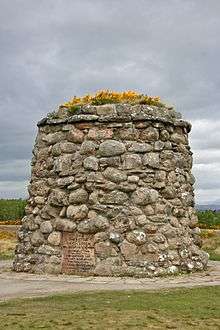
.svg.png)